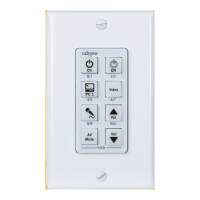24
Network (NET) Commands*
Syntax: #NET[Connection, StringType, Device, ‘Command’];
Name Required/Optional Data Type Format Description
Connection Required Variant Fn
where n is 1 or 2
Defines the connection type:
• TCP/IP (1)
• UDP (2)
StringType Optional Variant Tn
where n is 1 or 2
Defines the string type:
• ASCII string (1)
• Hexadecimal (2)
If you leave StringType blank, a
default of T1 is assumed.
Device Required Variant If using Macros (recommended):
@{MacroName}
For explicit device references:
IAddress, PPort
Default port for CB2000 is 7267
A string expression that’s the valid
name of a Macro (see Appendix
A.2) or the IP address and port of
device to be controlled.
Command Required Variant Specific to device. For CM3000
commands, see Appendix D;
for other device commands see
manufacturer’s instructions.
A string expression that contains
the command.
Example (increments the audio input channel of a CM3000 by one over TCP/IP protocol using an ASCII string):
#NET[F1, @{CM3000}, ‘#AUD1[I+];’];
Intercom (HTP) Commands*
Syntax: #HTP[http://Server/calypso/conductor/?/call/Device];
Name Required/Optional Data Type Format Description
Server Required Variant If using Macros (recommended):
@{MacroName}
For explicit device references:
IP address of the Conductor
server
A string expression that’s the valid
name of a Macro (see Appendix
A.2) or the IP address of the Con-
ductor™ server.
Device Required Variant If using Macros (recommended):
@{MacroName}
For explicit device references:
IP address of the CM3000
A string expression that’s the valid
name of a Macro (see Appendix
A.2) or the IP address of a CM3000
located on the network
Example (initiates a proxy intercom request from the CM3000 located in the office):
#HTP[http://@{DRS5000}/calypso/conductor/?/call/@{OfficeCM3000}];

